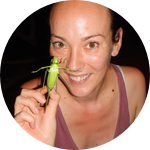About This Project
There are 40,000+ species of spider in the world. Spiders are beneficial predators & an integral part of a healthy ecosystem. My goal is to find out if there is a quantifiable relationship between morphology and foraging behavior of spiders. Based on preliminary research I conducted in the Ecuadorian Amazon, it seems the answer is yes! The more we understand about these animals, the more we can protect rainforest ecosystems as a whole.Ask the Scientists
Join The DiscussionWhat is the context of this research?
Ecomorphology, or the study of how a animal's physical traits shape their lifestyle, has been applied to many organisms. Everything from snakes, insects, and monkeys have been studied in this field. However, little is known about the role a spider's morphology (how they look) plays in its foraging behavior.
I want to know if each guild (type) of spider can be recognized by their body shape. There are 5 distinct guilds of spider: the web weavers, wanderers, jumpers, fishers, and foliage runners. Is there a ratio based on body shape that can predict which guild a spider belongs? If so, which body part is most important in determining a how a spider obtains its resources?
Any trends in morphologies amongst guilds that are determined will help shed light on spider evolutionary history .
What is the significance of this project?
The field of Ecology has been increasingly critical in conservation of a variety of ecosystems worldwide. An understanding of how organisms interact with their physical environment and other organisms helps to provide the tools necessary in conservation of ecosystems.
Across the globe, ecosystems are changing. In light of a changing climate, habitat devastation due to increased invasive species, increased cases of insect-borne diseases, beneficial predators have become our best natural defense.
I want to contribute to science's understanding of how a spider's morphology shapes their ecology. The more we understand about a spider's ecology, the more we can protect them, while simultaneously protecting the habitats they reside in.
What are the goals of the project?
- Capture as many individual spider species as possible
- Identify all spiders to family level
- Make following measurements: Abdomen width and length, Cephalothorax width, body length, and length of one of each pair of legs
- Create indices for each measurement based on body length
- Run a Discriminant Function Analysis (SYSTAT13) for the indices
- Identify any trends in morphologies amongst foraging guilds
Budget
In order for the project to be a success, I need to return to the remote Tiputini Biodiversity Station deep in the Ecuadorian Amazon of Yasuni National Reserve where I can collect as many spider species as possible. This location is the most biodiverse location on the planet. The Amazon is home to roughly 90% of all spider/insect species. This location will help to illuminate as much knowledge about my study subjects as possible.
The Yasuni National Reserve is one of the last completely pristine tropical rainforest habitats in the world. Recently, Ecuador rejected a petition to stop oil drilling from destroying this biodiverse hot spot. Over 80% of the insect/spider species here are unknown to science. Drilling could wipe them off the planet before we even know they exist. Research in this mega-diverse area is more crucial now than ever before. The more we know about the inhabitants of the rainforest, the better we are equipped to protect them.
Your generous donation will cover travel costs to Yasuni and allow for a 2 month stay in the rainforest. Lodging includes 3 daily meals and access to all the station's research facilities. It is here that I will collect, identify, and measure the spiders in the lab. All spiders will then be released at place of capture. All funds raised will go toward transportation, field supplies, and lodging.
Stretch Goals
Any funds raised over my goal will be used to add additional study sites to the project (Maquipucuna). More research locations will provide a broader picture of the project.
If I double my goal, I will hire a research assistant. Capturing and measuring spiders in the jungle is hard work! Extra hands would be a dream come true for me and the lucky research assistant that will accompany me in the field.
Endorsed by
Meet the Team
Team Bio
Ever since I was a little girl, I have been fascinated by all things creepy crawlie! That fascination propelled me to return to school and study my passion. I have recently earned a B.S. in Evolution/Ecology from Cal State Northridge. While at CSUN, I had the incredible opportunity to go to the Ecuadorian Amazon, where for two months I conducted independent research on spiders.
I am hoping to turn that research into my thesis project. I have recently been accepted as a fully classified M.S. student in Dr. David Gray's lab at CSUN.
In my free time, I like to go bug hunting, scuba diving, travel, and I am also Buggirl on Tumblr. I enjoy spending hours blogging about the various creatures I encounter and teaching others interesting facts about insects and spiders. I credit my experience on my blog to launching my professional career as a researcher in the field of Entomology.
Additional Information
Any donation from a tumblr user will receive a public thank youon my entomology blog that has a reach of over 158,000 unique readers. Thank you for following and supporting buggirl.
Related Links:
Tiputini Biodiversity Research Station
A rainforest in trouble: oil drilling in Yasuni National Reserve
http://ecotourism.maqui.org/
Project Backers
- 170Backers
- 107%Funded
- $5,427Total Donations
- $31.92Average Donation



